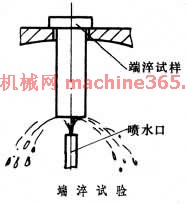1) heat-treating machine


热处理机
2) heat-treatment mechanism


热处理机理
3) TMCP


机械热处理
1.
The Development of TMCP and Relaxation-Precipitation-Control Transformation(RPC) Technology;
机械热处理工艺的发展及弛豫—析出—控制相变技术
2.
By a special thermomechanical control process(TMCP-RPC), relaxation for a certain time after control rolling and then direct quenching/accelerated cooling, the strain induced precipitions and defect structure in deformed austenite resulted in refinement of intermediate transformation microstructure.
利用一种特殊的机械热处理工艺技术,即在控轧终轧后经过一段控制时间与温度的 弛豫,使得基体中出现应变诱导析出以及变形奥氏体中缺陷组态重组,在随后的直接淬火或加 速冷却过程中,获得细化的板条贝氏体/马氏体组织。
4) thermomechanical processing


机械热处理
1.
The superplasticity of 01420 Al-Li alloy was studied by means of simple tension,and good superplasticity of the alloy was found after suitable thermomechanical processing.
采用单向拉伸对01420Al-Li合金进行超塑性研究,发现该合金经过适当的机械热处理后能获得良好的超塑性。
2.
This paper details the influence of thermomechanical processing (TMP) on the microstructures and mechanical properties of TC21 titanium alloy, a new alpha+beta alloy with high strength, ductility and toughness developed in China.
TC21合金是我国自行研制的一种新型高强高韧两相钛合金,本文主要对合金机械热处理工艺、微观组织和室温机械性能之间的关系作了系统的研究。
5) thermomechanical processing


热机械处理
1.
An(α2+O+B2) three-phase Ti3Al-based alloy,designated as TD3 alloy,is presented,including the thermomechanical processing technology,the microstructure control and the mechanical properties of some typical microstructures of TD3 alloy bars and forgings.
本文介绍了一种中等Nb含量的(α2+O+B2)三相Ti3Al基合金(TD3合金)的热机械处理工艺和微观组织特征,以及典型组织的力学性能,并与一些典型的O相基合金,高温钛合金,高温合金进行了对比。
2.
The effect of thermomechanical processing (TMP) on the morphologies and room temperature tensile properties of lath microstructure in Ti 3Al based alloy, Ti 24Al 14Nb 3V(at%), has been studied.
研究了热机械处理(TMP)对Ti3Al基合金Ti-24Al-14Nb-3V(原子分数,%)板条组织的形貌及室温拉伸性能的影响。
6) thermo-mechanical treatment


热机械处理
1.
The effect of thermo-mechanical treatment on microstructure and properties of CuCrZrBeRE alloy and strengthening mechanism were studied.
研究了热机械处理对CuCrZrBeRE合金组织及性能的影响 ,探讨了合金的强化机理。
补充资料:机械工程材料:热处理工艺性试验
测定材料或零件在热处理工艺过程中获得预期热处理效果的难易程度的工艺性能试验。由於热处理工艺的多样性﹐不可能用单一的性能指标来表徵和评定。常见的热处理工艺性能有淬透性﹑晶粒长大倾向﹑淬裂敏感性﹑脱碳敏感性﹑回火脆性等。
淬透性 表示钢在淬火时整个截面被淬硬的深浅程度﹐一般用钢在淬火时能够在整个圆柱截面上淬硬的最大临界直径表示。最常用的淬透性标準试验方法为端淬试验法。採用这种方法时﹐将规定尺寸的试样加热到淬火温度﹐然后在试验机上一端喷水冷却(见图 端淬试验 ) ﹐试样完全冷却后测定沿其整个高度上的表层硬度分布﹐以端面至淬硬到规定硬度值的距离表徵。
﹐试样完全冷却后测定沿其整个高度上的表层硬度分布﹐以端面至淬硬到规定硬度值的距离表徵。
晶粒长大倾向 或称过热敏感性﹐指金属在加热过程中晶粒粗化倾向的大小。一般测定不同温度时金属的晶粒度﹐以晶粒开始急剧长大时的温度来衡量晶粒长大倾向。
淬裂敏感性 金属在淬火时產生裂纹的倾向。没有统一的标準评定方法﹐一般用一定形状的试样经不同冷却能力的淬冷介质淬火后﹐统计出现裂纹的多少来进行相对比较。
脱碳敏感性 钢在加热和保温过程中表层的碳逸出氧化的倾向。一般将试样在相应的加热环境下保持一定时间后﹐用金相法或剥层分析法测定脱碳层的深浅来评定。这对轴承﹑刀具﹑模具﹑弹簧等用钢是一种很重要的指标。
回火脆性倾向 淬火钢在400~600℃温度区间回火时的脆化现象﹐也称可逆回火脆性。一般用钢在回火后慢冷状态下和水冷状态下的衝击韧性比值大小来衡量﹐也可以用回火后快冷和慢冷两种不同状态下钢的脆性转折温度的变化大小来衡量。
淬透性 表示钢在淬火时整个截面被淬硬的深浅程度﹐一般用钢在淬火时能够在整个圆柱截面上淬硬的最大临界直径表示。最常用的淬透性标準试验方法为端淬试验法。採用这种方法时﹐将规定尺寸的试样加热到淬火温度﹐然后在试验机上一端喷水冷却(见图 端淬试验 )
 ﹐试样完全冷却后测定沿其整个高度上的表层硬度分布﹐以端面至淬硬到规定硬度值的距离表徵。
﹐试样完全冷却后测定沿其整个高度上的表层硬度分布﹐以端面至淬硬到规定硬度值的距离表徵。 晶粒长大倾向 或称过热敏感性﹐指金属在加热过程中晶粒粗化倾向的大小。一般测定不同温度时金属的晶粒度﹐以晶粒开始急剧长大时的温度来衡量晶粒长大倾向。
淬裂敏感性 金属在淬火时產生裂纹的倾向。没有统一的标準评定方法﹐一般用一定形状的试样经不同冷却能力的淬冷介质淬火后﹐统计出现裂纹的多少来进行相对比较。
脱碳敏感性 钢在加热和保温过程中表层的碳逸出氧化的倾向。一般将试样在相应的加热环境下保持一定时间后﹐用金相法或剥层分析法测定脱碳层的深浅来评定。这对轴承﹑刀具﹑模具﹑弹簧等用钢是一种很重要的指标。
回火脆性倾向 淬火钢在400~600℃温度区间回火时的脆化现象﹐也称可逆回火脆性。一般用钢在回火后慢冷状态下和水冷状态下的衝击韧性比值大小来衡量﹐也可以用回火后快冷和慢冷两种不同状态下钢的脆性转折温度的变化大小来衡量。
说明:补充资料仅用于学习参考,请勿用于其它任何用途。
参考词条